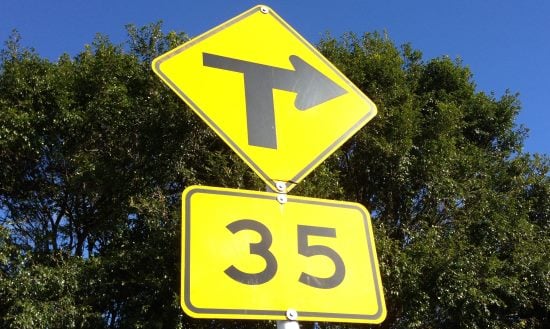A. 35 car parks on the left
 What does this sign mean?
What does this sign mean?
A. 35 car parks on the left
B. A corner in 35 metres
C. The recommended speed for this corner is 35km/h
If you are towing a trailer or driving a heavy vehicle or high-sided vehicle you may need to drive slower than 35kph around the corner. High-sided vehicles are more likely to tip over on sharp corners.
NZTA has guidelines for whether a corner requires these signs, what size they should be and how far before the curve they should be situated.
The signs are from 15-95kph in 10kph increments. This way you can tell between speed limit signs and advisory signs. Read more about speed limits vs advisory speeds here. A 35kph sign covers the range 31-41kph.
The figure is measured by driving a vehicle around the curve at a constant speed and measuring the lateral forces acting on the vehicle using a side thrust gauge. Two runs that yield the same result must be made for a sign to be adopted.
The speed set for the curve is 15kph less than the 85th percentile curve approach speed for speed of 30-60kph, i.e. the speed at which the top 15% of traffic would approach the curve, i.e. the speed just before the traffic begins to slow down. Therefore if the sign says 15kph then the 85% percentile is travelling at 30kph. For speeds of 80-90kph the advisory speed is 25kph less. For 110-130kph the advisory speed is 35kph less. These speed guidelines were set in the 1990s and are now out-of-date because overall speeds are lower and vehicle capabilities are higher. Although this doesn't stop surprisingly frequent rollovers of heavy vehicles each year through misjudging the corner.
Signs are placed at least 120m ahead of the curve in rural areas and 60m ahead of the curve in urban areas.
 Suggested or advisory speeds are always found ending in 5. They are almost always for cornering and are either in a yellow rectangle, or attached to chevrons.
Suggested or advisory speeds are always found ending in 5. They are almost always for cornering and are either in a yellow rectangle, or attached to chevrons.
The speeds are set using a formula based on measured speed before the corner and not actually what vehicles are capable of. For example, as you approach a tight left hand bend it might be signposted 45kph. Drive the other way and it becomes a right-hand bend and might be signposted 45 to 65kph (depending on the angle, camber and visibility).
This suggests a comfortable speed in dry weather, but not necessarily what an experienced driver would take the corner at. As a learner driver, it’s advised to stick to these speeds until you understand whether your vehicle is capable of more, you have better judgement, and you know that particular road. Cornering is all about taking the right line, and taking the wrong line on a corner with an advisory speed could mean that you go off the road.
If it is wet, exercise more caution, particularly if you see signs such as ‘Slippery when wet’ on the approach to the corner.

The sign below indicates that the priority route has a sharp right-hand turn with an advisory speed of 35kph.

Because suggested speeds and regulatory speeds are always written differently and on different coloured signs, there’s no chance of confusing them.